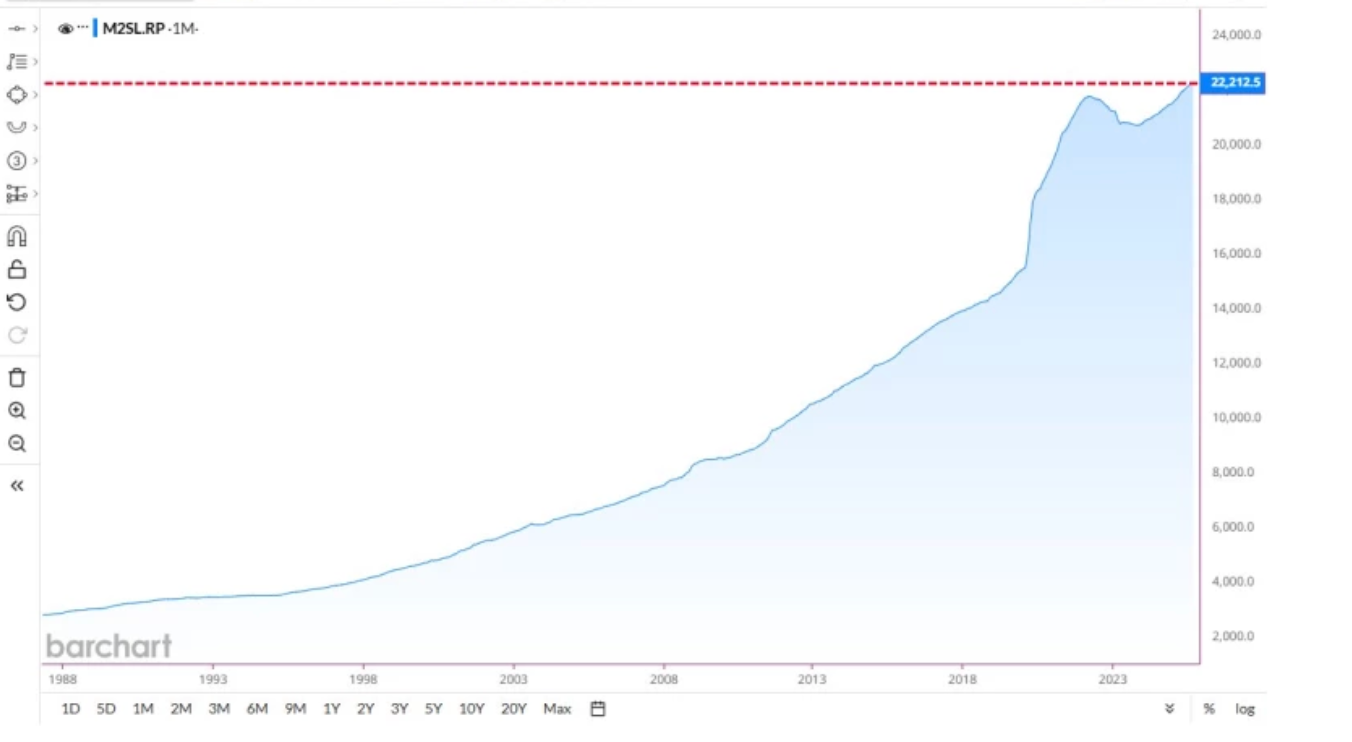Bitcoin’s liquidity puzzle: Why it’s cooling below $110K despite a money surge
Bitcoin’s liquidity puzzle: Why it’s cooling below $110K despite a money surge
Bitcoin’s liquidity puzzle: Why it’s cooling below $110K despite a money surge

Bitcoin’s cool-off below $110,000 in November isn’t a sign of fading momentum - it’s a reflection of timing. Global liquidity is expanding again as central banks loosen their policies to support slowing growth, but Bitcoin, typically the first to react to easier money, has remained surprisingly calm.
ETF outflows, softer institutional appetite, and the Federal Reserve’s cautious stance have kept risk appetite subdued. The result? A paradox: liquidity is returning to the system, yet Bitcoin - the market’s traditional barometer for monetary easing - remains on ice.
In short, Bitcoin isn’t ignoring liquidity; it’s simply waiting for it to matter. Historically, the cryptocurrency market lags behind traditional assets when liquidity expands, rallying only once investor confidence has been established. This November, that delay is what’s keeping Bitcoin cool despite one of the fastest global money supply rebounds in years.
Key takeaways
- Bitcoin steadies near $110K after Uptober’s rally, weighed down by ETF outflows totalling nearly $700M.
- Global M2 money supply has grown 8% in 2025, driven by injections from the U.S., China, and Europe.
- Despite two rate cuts, the Fed’s hawkish messaging has curbed investor optimism.
- A break above $117K could trigger over $8B in short liquidations and a sharp upside reversal.
- The global liquidity trend remains supportive of Bitcoin’s long-term prospects.
Bitcoin ETF outflows signal institutional caution
Bitcoin ETFs saw $470.7 million in net outflows, with FBTC and ARKB leading the redemptions. Ethereum ETFs weren’t spared either, losing $81.44 million over the same period. This reversal follows months of strong inflows that helped propel Bitcoin to $124K in August.
According to Glassnode, the data shows rising sell pressure from traditional finance investors and weakening institutional conviction. Large funds that powered earlier rallies are now reducing exposure - likely rebalancing portfolios ahead of year-end or hedging against further Fed hawkishness.
Crucially, these withdrawals came right after the Federal Reserve’s second consecutive rate cut, which most traders expected to spark a broader risk rally. Instead, the Fed’s tone in December turned defensive, suggesting the cuts were more about caution than confidence - and institutions took note.
Rate cuts without confidence: The Fed’s hawkish paradox
Bitcoin’s muted response reflects a deeper policy contradiction. The Federal Reserve has lowered interest rates twice this quarter, easing some post-pandemic tightening. But Chair Jerome Powell’s reminder not to “assume further cuts” left markets wondering whether this is true easing or just crisis prevention.
This tug-of-war between dovish action and hawkish rhetoric has left traders in limbo. Policy support is coming, but the tone from the Fed signals unease - and that uncertainty has stifled risk assets, including Bitcoin.
Friday’s session on Wall Street summed up the mood: stocks softened, and Bitcoin slid below $106,500 before bouncing back to $111,500 over the weekend. That rebound, however, quickly hit resistance, confirming that investors are waiting for clearer signals before jumping back in.
Global money supply expansion: Bullish backdrop-delayed Impact
Behind the short-term indecision lies a far more constructive macro story. Central banks worldwide have resumed liquidity expansion, reversing much of the tightening from 2022–2023 to counter slowing growth and deflationary pressure.

- United States: M2 money supply is up 5% year-on-year, surpassing its April 2022 peak - signalling the end of quantitative tightening.
- China: Facing deflationary pressures and youth unemployment, China saw an M2 growth rate of 8.5% in September.
- Japan: The Bank of Japan remains firmly committed to ultra-loose policy, even as the yen continues to weaken.
Overall, global M2 growth is tracking around 8% in 2025, a historically strong rate of liquidity creation. In prior cycles, such expansions have preceded major Bitcoin rallies - though typically with a lag of several months.
If you’re tracking these cycles, Deriv MT5 offers real-time charting and analysis tools to follow how global money trends interact with Bitcoin’s movements.
Liquidity and lag: Why Bitcoin hasn’t reacted yet
Bitcoin’s slow reaction doesn’t necessarily reflect weakness - it reflects sequencing. Liquidity expansion tends to lift equities, bonds, and credit markets first before spilling into high-volatility assets like Bitcoin.
This pattern has repeated throughout multiple cycles:
- After the 2020 COVID stimulus, Bitcoin lagged the equity rally by about four months before breaking above $60K.
- During the 2021 policy pivot, Bitcoin didn’t track M2 growth until traditional markets stabilised.
The 2025 environment looks much the same. Liquidity is flowing, but institutions are still cautious, waiting for macro certainty. Bitcoin’s next rally, then, likely depends not on if liquidity filters into crypto, but when.
Elon Musk and the debt spiral narrative
Adding a layer to the macro debate, Elon Musk has reignited concerns about U.S. debt sustainability. With national debt surpassing $38 trillion and interest costs now higher than defence spending, Musk warned the country is “hurtling toward bankruptcy.”
On The Joe Rogan Experience, he argued that only breakthroughs in AI and robotics could offset spiralling costs through higher productivity. His criticism of fiat currencies as “hopeless” aligns closely with Bitcoin’s founding philosophy - a decentralised hedge against systemic fragility.
While Musk’s words alone don’t move markets, they echo a growing sentiment: that reliance on debt-driven liquidity may be fuelling long-term instability, making Bitcoin’s scarcity-driven model increasingly appealing.
Technical overview: Consolidation with uptrend intact
On the charts, Bitcoin remains range-bound near $107,352, a support zone that’s held since October. A decisive drop below this level could open the door to $104K–$102K, while resistance at $115,270 and $124,800 remains a ceiling for now.
The RSI sits below the neutral 50 mark, showing soft momentum, while Bollinger Bands have tightened - often a sign that volatility is about to pick up.

Analyst Ali Martinez highlights that Bitcoin’s broader trend still points upward, defined by higher highs and higher lows since its 2022 bottom. With the biggest drawdowns already behind it, the market’s “worst phase” may well be over.

If Bitcoin breaks above $117K, over $8 billion in short positions could be wiped out - potentially triggering a sharp upside move.
Traders can use Deriv’s trading calculator to plan entry and exit levels while managing risk and margin exposure.
Breakout or breakdown: What defines the next phase
The coming weeks could decide whether Bitcoin’s pause is a healthy consolidation or an early reversal in its broader uptrend.
Bullish case:
- Liquidity expansion continues, ETF outflows stabilise, and a clean break above $117K sparks short covering and renewed institutional interest.
Bearish case:
- The Fed keeps a hawkish tone, risk appetite stays muted, and Bitcoin revisits $100K–$102K support before finding its footing.
The December Federal Reserve meeting could serve as the next major catalyst - potentially setting Bitcoin’s trajectory into 2026.
Bitcoin investment implications November 2025
For short-term traders, Bitcoin’s current consolidation presents tactical opportunities between $105K and $110K, though volatility remains tethered to macro headlines.
For long-term investors, the message is clearer. Global liquidity is expanding, debt is surging, and central banks continue to favour growth over austerity. In that context, Bitcoin’s cooling phase looks less like fatigue and more like preparation.
This is likely a pause before the next acceleration, positioning Bitcoin as one of the few assets poised to benefit once liquidity fully spills over into the speculative phase.
The performance figures quoted are not a guarantee of future performance.















